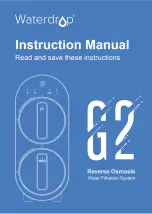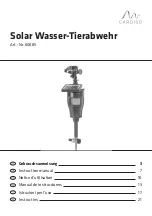
EN
MANUAL XCLEAR 3 CHAMBER FILTER 220L/330L & 220L/330L + 40 WATT UV-C |
9
Drawing A
• The filter baskets (D) are placed in a tilted position in the filter for shipment. They must be
removed from the filter before proceeding with the installation.
Drawing B (with UV-C) & G (without UV-C)
• The (lamp) lead-through (A) is sealed with one sealing ring (N) on the outside of the filter
wall and with one gasket (N) on the inside of the filter wall. The filters without UV-C have
only a gasket on the outside, not on the inside of the filter wall. The black reactor tube (only
for the filters with UV-C) is inserted through the outer wall and the two partitions. The nut
(O)
is tightened hand-tight on the inside of the outer wall.
Drawing C
• The outlet of the filter (L) consists of a 63 mm tank lead-through (S) with counter-flange (P)
and sealing ring (Q), which must be secured to the outlet hole with screws (R). You have
to use the supplied longer screws. The short screws, that are standard assembled in the
transit, are unnecessary than.
• If you choose a configuration that is not near the pond, the outlet can be extended with a
pipe or hose so the water flows back into the pond.
• Make sure the hose(s) and/or tube are fitted so there is no stress on the connections.
Drawing D (only for the filters with UV-C)
• Slide the O-ring (R) over the thicker section of the glass sleeve holder at the end of the
quartz glass sleeve (T). Fit the second O-ring (R) in the recess at the end of the glass sleeve
holder.
• Then slide the quartz glass sleeve (T) completely into the lead-through (A) (which is already
fitted in the filter), pressing the O-ring (R) in place, making the connection waterproof. Do
this slowly and carefully.
• Place the lamp (C) in the lamp holder (W). Drawing 3: Slide the lamp (C) into the quartz glass
sleeve (T), which is inside the filter, and tighten it to the lead-through(A) by hand.
• Install the ballast (Y) in a dry/sheltered place.
Drawing A
• Screw the adaptor (G) for the 1’’ tap into one of the three openings (F) of the sludge
collection areas where the waste is to be collected. The other two openings must be sealed
with plugs (H). Some Teflon tape may be necessary to obtain a good seal.
• Hand-tighten all the plastic parts. If excessive force is applied while tightening, this could
cause the plastic material to crack, which is not covered by the warranty.
• Use hard PVC glue to connect the supplied gate valve (I) to the adaptor (G). If required,
connect a discharge hose or pipe from the gate valve to the sewage system or the area
where you wish to discharge the sludge.
• Fit the two pipes (J) between the filter walls in the holes provided for that purpose. The










































